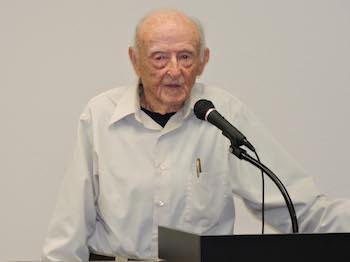 April 25, 2017 - The membership of the Timpson Area Genealogy and Heritage Society and guests were honored to have Terrell Childs speak at their April monthly meeting. It was heartwarming to see and hear this 97 year old WWII Veteran, who insisted that he stand for the full 90 minutes while he spoke. His story kept his audience spellbound and wanting to know more of the story, of which he said he “only scratched the surface”.
April 25, 2017 - The membership of the Timpson Area Genealogy and Heritage Society and guests were honored to have Terrell Childs speak at their April monthly meeting. It was heartwarming to see and hear this 97 year old WWII Veteran, who insisted that he stand for the full 90 minutes while he spoke. His story kept his audience spellbound and wanting to know more of the story, of which he said he “only scratched the surface”.
Something would be lost if an effort was made to paraphrase the information communicated by Terrell. For this reason the following is an accounting, in his own words, of his life as a US Army Air Corpsman during WWII.
In 1939, following graduation from Timpson High School, I and a cousin, Phillip Childs, went to Barksdale Air Base and took the qualifying test to become members of the Army Air Corp, a precursor to the U. S. Air Force. We served together during the three years before the war, 1939, 1940 and 1941.
We had two big old Harley Davidson motorcycles and our favorite thing was riding those motorcycles and flying airplanes.
When WWII was looming, we got separated and Phillip stayed at Barksdale while I was assigned as the senior NCO to a cadre that was forming a new bomb wing. Our duty station was on a base just south of Oklahoma City. My job was to monitor and inspect the work of three shifts of air craft mechanics who were charged with installing bigger, more powerful engines into aircraft and making them ready to fly for use by the military. Many of the mechanics were new to the job of mechanic and required close supervision for such an important task. An added difficulty was that we were required to do our work in the field.
Sleep was something that I didn’t get much of.
One Sunday morning in December of 1941, I had gone to the barracks to get a quick nap. I had laid down across my bunk, in my greasy clothes and was sleeping soundly. At about 10 a.m. one of the mechanics woke me up and told me I needed to get up and listen to what was being said on the radio. We all listened as the announcer described the bombing of Pearl Harbor, the loss of American lives and the damage done to the American fleet.
We all got back to work with a new purpose.
The process that we followed was to change out the engine, then I would inspect the hookups. We would fire the engines up and verify that they were running properly. While the engine was being run up, I always had the maintenance chief of the bomb wing sitting right beside me in the cockpit. This proved to be a wise move on one particular engine check. When an aircraft passed all the checks, I would call for a test pilot to fly the plane. The test pilot got in the plane and took it down to the end of the runway to attempt a takeoff. When he pushed the throttle forward, the engine died. That type of plane was built for England where, to speed up the engine, the throttle was to be pulled back. The test pilot didn’t know this so he followed his standard practice of pushing the throttle forward, which killed the engine. When the engine is dead, the hydraulics don’t work and you have no brakes. Not knowing what to do, the pilot turned the aircraft around and headed to the flight line parking area. He coasted it in but he couldn’t stop it and he struck another plane. The pilot was furious when he got out of the plane and sent for me. I went into the office with him and the maintenance chief. The pilot was ranting and cursing me and blaming me for the incident. The Maintenance Chief, who was either the same rank or a higher rank than the pilot threw his support behind me because he had personally witnessed me going through the check process. It was the responsibility of the pilot to know the operation of the plane before he put it into a roll. He didn’t do that. The maintenance chief told him to get out of the office.
We worked diligently to get the plane ready to fly because we knew that America was going to become embroiled in the war at any moment.
Our Wing was transferred to Savannah, Georgia to finish our training to get us combat ready. I had passed the pilot test so, when we got to Savannah, I was given the choice of going through combat pilot training or staying on the maintenance line. I elected to stay with my Wing as we went into combat.
Early in March of 1941, we loaded the air craft aboard ships to transport them to where they were needed. They did not have the range capability to be flown to their destinations.
Since my name started with “C”, I was in the first echelon. From Savannah, we went to England where we were charged with getting our Wing, the ship and our equipment ready for invasion. We didn’t know where the invasion would occur but we knew we were to be a part of it. From England we went to Belfast, Ireland where some of the equipment was unloaded. Our arrival in Ireland was one of the most enjoyable moments of the trip. When we arrived, the docks were lined with Irish girls; lots of them, all waving to us and calling out their names.
We got our orders and they were that one man would fly the aircraft to its destination. All other available space in the craft would be filled with a rubber bag filled with fuel. This told us that the craft was being flown to the site of the invasion.
We had a total of 13 planes. That tells you how short our military power was.
The first cadre of men consisted of thirteen crew chiefs, of which I was one, with three men on each crew, plus cooks and other support personnel who went with us.
We landed right behind the Army in Oran, North Africa. We were supposed to dock in the harbor at Oran but when we got there the harbor was full of sunken ships. It was dark when our ship put in above the harbor in a shallow area and we disembarked and waded ashore, passing floating bodies as we went. I was 20 years old. I and a forty year old Master Sergeant was put in charge. Our orders were to get the troops to an air base thirty miles away where our thirteen aircraft were supposed to be shipped and we had to get there before our planes arrived.
Using a map and a compass, we set out. We had one blanket, a change of clothes, one Thompson sub machine gun and three clips of ammunition. We walked until midnight and decided the men needed a rest.
During the day, the temperatures reached 100 degrees in that desert, but when the sun went down it got very cold. No one could rest because of the cold so we got everyone up and told them that we were going to push non-stop toward the base. We met some military along the way who told us that the base had not been secured and to be prepared that there might be Germans and Italians there. We got to the base before the A-20s and the Army had the base secured so our arrival went without incident.
When our planes arrived, we set about preparing them for use. The rubber fuel bags were removed and fuel lines capped off. Gun, ammo and bomb racks were reinstalled.
We got orders to move up the coast to Algiers. When we landed there, we were wise enough to scatter the A-20s out in the dirt off the runway and near an olive orchard. Along about dark, nine B-17s landed. They made a beautiful site lined up along the runway.
I was sitting astride an engine that I was working on when out of the night came some airplanes that ran the length of the runway bombing and strafing the base. I jumped down and headed into the olive orchard. I had a good friend named Glen Jackson on my crew. He had joined the military after two years of college because he had grown tired of school and helping his dad in the plumbing business. Glen constantly bragged that he would not be scared to engage in the activities of war. I was deep in the olive orchard and I didn’t know where Glen had gone to. Bombs were falling all around me. I hollered for Glen. When he responded, I asked him if he still had no fear of the war.
One time I happened to be in the area where Jimmy Doolittle, the 12th Army Corp Commander, and another officer were discussing where we would go for our first combat operation. I was hoping we would retreat but they decided we would move forward and operate out of a base that had a little non-improved air strip in a dry lake bed. It didn’t even look like an air strip but we operated out of that base from October through December.
We didn’t get enough parachutes for everyone so I was flying without a chute. I felt pretty safe though because we flew so low that we sometimes stirred the dust on the ground.
It amazes me now to think of what we did with so little. Our supplies were delivered by C47 cargo planes. The bombs weighed 500 lbs. We used 50 round machine guns. We serviced those planes with 5 gallon cans and muscle. We loaded the bombs, reloaded the ammunition and did everything that needed to be done to ready the planes for another flight.
Jimmy Doolittle later made note to the nation that our thirteen A-20s flew 80% of the bombing and strafing missions flown in that little corner of North Africa. We did finally start getting some B17s and B24s.
When Gen Montgomery and the British 5th Army were about to surround Field Marshal Rommel in Egypt, Rommel’s plan was to get his army out of North Africa and into Italy by bringing them up the Mediterranean through Tunisia. He had pushed the 3rd Army under Patton up through Castleman Pass toward our base. Seeing that the 3rd Army was running, we knew we needed to run too. It was December and the monsoon season had set in. We couldn’t get our planes off the ground because of the mud. They sent crews in to lay sheets of runway material so that C47s could come in and pick us up. Amazingly, a pilot of one of the C47s was Sheryl Bailey from Timpson. I flew with Bailey to a R&R area.
The recreation area was not far from a depot where they disassembled airplanes and took the parts to build flyable planes. I got tired of messing around the recreation area and went down to the depot to watch their operation. After watching what they were doing, I knew that our men sitting around in the recreation area could be making flight ready planes out of the parts and materials in the depot quicker and better than all the people that they had working there. I went to the CO of the depot with my idea and he said “Come on!” I picked us a crew of good mechanics and we went to work. We worked on P38s and P51s. One B17 came in and I grabbed it because me and the other men in the crew had never worked on one. There was one hangar that was still pretty much together. I wanted the B17 in the hangar but it was too big. I decided to taxi it down to the hangar. I didn’t know a thing about how to operate it but I got in there and cranked it up. My plan was to taxi it right up to the hangar. I had all four engines running and the plane headed in that direction. The line chief from the depot was jumping up and down and hollering for me to stop. It tickled me because I had had some trouble with him before. I got the nose and the engine inside the hangar before I shut it down.
I got a set of secret orders to go to Italy and search out German airplanes, make them flyable and have them flown back to North Africa. The purpose was to have some that could be shown to incoming flight crews so that they would recognize the German planes before they started shooting at them. A B25 airplane and flight crew was assigned to haul me around Italy for this purpose. The 5th army had overrun a base so fast that the Germans did not have time to move or destroy their planes. I found two single seaters; a 109 and a FW190. We made them flight ready and turned them over to the pilots to fly back to North Africa.
On a harbor base In Bari, Italy, I found a Messerschmitt 110 which is a twin engine German bomber plane. I thought I could fix it and get it to North Africa. To keep it safe, we got the plane and had it towed to an airfield out away from Bari.
A few days later, the crew chief of the B25 talked me into going into town. He said I could take a bath and sleep in a real bed if I went. There was a long boulevard lined by beautiful trees that ran through the town and down to the harbor where ships docked. It was already dark and I was relaxing under one of those trees. An ammunition ship was at the harbor and unloading was in progress. The area was well lit for the unloading. A flight of 15-20 Messerschmitt 110s flew over the town, circled and came back using the boulevard as their flight path to bomb the munitions ship. They bombed the ship over and over. Between the bombing and the explosions of the munitions, the ship was totally destroyed.
The Lord was with me as I sat there under the tree listening to the bombs explode and seeing the shrapnel falling all around me. Nothing hit me.
There was another time that I and a buddy were walking down the flight line toward our plane. A 110 flew over us, banked and headed straight back at us. There was no place to go except some deep truck tracks near where we were walking. We laid down in those truck tracks. As the 110 flew over us, the rear gunner was firing a 32 caliber machine gun. Dirt clods were kicking up and falling all over us but we were not hit by the machine gun fire.
Let me tell you, I depended on the Lord all of the time. I was twenty years old when I entered combat. Like most of the men I served with, I did not think that I would live to come home. We knew the power of the German and Italian military machine. I depended on the Lord throughout and He kept me safe time after time.
The Germans knew how to build things even though they didn’t have the machines that we had. The 110 was a beautiful plane and a very effective tool for them in North Africa and Italy.
Anyway, I got the German 110 running. When I ran the engine up, it threw some engine valve parts in the oil system. We didn’t have replacement part so we got in the old B25 and went looking for parts. We had to visit 2-3 places but we found what we needed. We took them back to base and dismantled and repaired the engine. We ran the engine up and checked the oil system filters. We felt pretty confident that it was safe to fly back to Africa so that is what we did. We flew this ME 110 from Bari, Italy down to the tip of The Boot and landed to refuel. We checked the plane over again to make sure it was holding together and we took off across the Mediterranean. We had not taken the German markings off of the plane so we had a B25 that flew right alongside us so we wouldn’t be mistakenly shot down. We flew it to the base in North Africa that we were supposed to carry it to and it was put into the use intended. We would fly it so that the crews could see it and learn to recognize it in the air and they were able to walk around it and admire it on the ground. One morning we took off on one of our show and tell missions. When we pulled the landing gear up, it went up through the wing and through some fuel cells and we started losing fuel. Those on the ground saw what had happened and the commanding officer sent a P51 up along- side us with a message printed on the side of it, “You guys bail out”. I was already thinking that was a good idea but when we pulled the lever to open the canopy, it wouldn’t open. I always carried a little tool kit in my pocket so I began taking the hinges off the canopy. That turned out not to be a good idea. I had gotten one side loose when the canopy rolled open and was hanging by the hinges on the other side. Those hinges gave away and it flew back and hit the tail section slicing the tail section about half in two. I looked back and the canopy, parts of the tail section, cables and wires were flopping all over the place. I changed my mind right quick about bailing out and possibly becoming tangled up in that mess.
Although the ranking officer on the ground suggested that we bail out, the rule was that the men in the plane made the ultimate decision. I and the other guy talked it over and decided we would rather take the chance of riding it down and it exploding, over bailing out and possibly getting hung up in all of the mess hanging from the tail section.
We decided it was best to land alongside the air strip on the gravel. We put it down and skidded for what seemed like a half a mile before we came to a stop. The emergency crew said we looked like a couple of squirrels when we came out of that cockpit, ran down to the wing tip of that plane and jumped the 15’ to the ground.
I injured my back when I landed on the grounded and it still often reminds me of that day. That was another amazing thing. Even with my injured back I was able to continue flying airplanes for a long time before I retired. They did eventually ground me and put me behind a desk. That wasn’t very good; but I have been retired a long time and I am blessed that I can still walk and get around.









